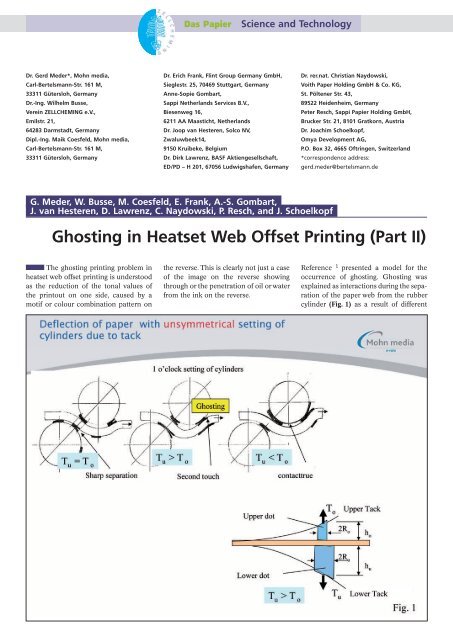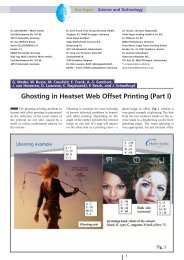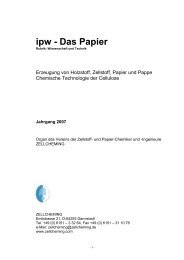Ghosting in Heatset Web Offset Printing (Part II) - Zellcheming
Ghosting in Heatset Web Offset Printing (Part II) - Zellcheming
Ghosting in Heatset Web Offset Printing (Part II) - Zellcheming
Create successful ePaper yourself
Turn your PDF publications into a flip-book with our unique Google optimized e-Paper software.
Dr. Gerd Meder*, Mohn media,<br />
Carl-Bertelsmann-Str. 161 M,<br />
33311 Gütersloh, Germany<br />
Dr.-Ing. Wilhelm Busse,<br />
Vere<strong>in</strong> ZELLCHEMING e.V.,<br />
Emilstr. 21,<br />
64283 Darmstadt, Germany<br />
Dipl.-Ing. Maik Coesfeld, Mohn media,<br />
Carl-Bertelsmann-Str. 161 M,<br />
33311 Gütersloh, Germany<br />
The ghost<strong>in</strong>g pr<strong>in</strong>t<strong>in</strong>g problem <strong>in</strong><br />
heatset web offset pr<strong>in</strong>t<strong>in</strong>g is understood<br />
as the reduction of the tonal values of<br />
the pr<strong>in</strong>tout on one side, caused by a<br />
motif or colour comb<strong>in</strong>ation pattern on<br />
Das Papier Science and Technology<br />
Dr. Erich Frank, Fl<strong>in</strong>t Group Germany GmbH,<br />
Sieglestr. 25, 70469 Stuttgart, Germany<br />
Anne-Sopie Gombart,<br />
Sappi Netherlands Services B.V.,<br />
Biesenweg 16,<br />
6211 AA Maasticht, Netherlands<br />
Dr. Joop van Hesteren, Solco NV,<br />
Zwaluwbeek14,<br />
9150 Kruibeke, Belgium<br />
Dr. Dirk Lawrenz, BASF Aktiengesellschaft,<br />
ED/PD – H 201, 67056 Ludwigshafen, Germany<br />
the reverse. This is clearly not just a case<br />
of the image on the reverse show<strong>in</strong>g<br />
through or the penetration of oil or water<br />
from the <strong>in</strong>k on the reverse.<br />
Dr. rer.nat. Christian Naydowski,<br />
Voith Paper Hold<strong>in</strong>g GmbH & Co. KG,<br />
St. Pöltener Str. 43,<br />
89522 Heidenheim, Germany<br />
6/2008<br />
Peter Resch, Sappi Papier Hold<strong>in</strong>g GmbH,<br />
Brucker Str. 21, 8101 Gratkorn, Austria<br />
Dr. Joachim Schoelkopf,<br />
Omya Development AG,<br />
G. Meder, W. Busse, M. Coesfeld, E. Frank, A.-S. Gombart,<br />
J. van Hesteren, D. Lawrenz, C. Naydowski, P. Resch, and J. Schoelkopf<br />
P.O. Box 32, 4665 Oftr<strong>in</strong>gen, Switzerland<br />
*correspondence address:<br />
gerd.meder@bertelsmann.de<br />
<strong>Ghost<strong>in</strong>g</strong> <strong>in</strong> <strong>Heatset</strong> <strong>Web</strong> <strong>Offset</strong> Pr<strong>in</strong>t<strong>in</strong>g (<strong>Part</strong> <strong>II</strong>)<br />
Reference 1 presented a model for the<br />
occurrence of ghost<strong>in</strong>g. <strong>Ghost<strong>in</strong>g</strong> was<br />
expla<strong>in</strong>ed as <strong>in</strong>teractions dur<strong>in</strong>g the separation<br />
of the paper web from the rubber<br />
cyl<strong>in</strong>der (Fig. 1) as a result of different<br />
Das Papier 2008–T56
6/2008 Science and Technology Das Papier<br />
Das Papier · Summary<br />
<strong>Ghost<strong>in</strong>g</strong> <strong>in</strong> <strong>Heatset</strong> <strong>Web</strong> <strong>Offset</strong><br />
Pr<strong>in</strong>t<strong>in</strong>g<br />
The ghost<strong>in</strong>g pr<strong>in</strong>t<strong>in</strong>g problem will<br />
be exam<strong>in</strong>ed on the basis of test<br />
samples and a test form (sample<br />
pr<strong>in</strong>touts and rubber blankets). It<br />
tack forces on the front and reverse and<br />
the consequent cont<strong>in</strong>uous reduction <strong>in</strong><br />
dot size. This reduction <strong>in</strong> dot size leads<br />
to a reduction <strong>in</strong> the tonal values and is<br />
the reason for lighten<strong>in</strong>g.<br />
<strong>Ghost<strong>in</strong>g</strong>, which only occurs after a<br />
certa<strong>in</strong> number of rollovers and which<br />
largely depends on the materials used<br />
– paper, <strong>in</strong>k, founta<strong>in</strong> solution, rubber<br />
blanket – is controlled by the tack forces<br />
and thus by the colour comb<strong>in</strong>ation on<br />
the two sides.<br />
Das Papier 2008–T57<br />
will be shown that the study of the<br />
deposits on the rubber blankets and<br />
the comparison with the deposits<br />
typical of the offset technique br<strong>in</strong>g<br />
about a greater understand<strong>in</strong>g of the<br />
phenomenon.<br />
The <strong>in</strong>fluence of the colour comb<strong>in</strong>ations<br />
on the two sides (front and reverse<br />
of the pr<strong>in</strong>ted page) on ghost<strong>in</strong>g will be<br />
exam<strong>in</strong>ed <strong>in</strong> greater detail here. First<br />
let us look at a number of examples of<br />
ghost<strong>in</strong>g <strong>in</strong> practice.<br />
Fig. 2 displays a pr<strong>in</strong>t sample <strong>in</strong> which<br />
only the colour black was pr<strong>in</strong>ted on<br />
both sides. The contour and darker area<br />
around the number on the reverse side<br />
can be clearly seen. The darker area<br />
is the one that is not affected by the<br />
2 www.ipwonl<strong>in</strong>e.de<br />
number and ghost<strong>in</strong>g is caused by the<br />
black reverse side around the number.<br />
Fig. 3 gives an example <strong>in</strong> which the<br />
red letter P on the reverse can be clearly<br />
seen as a bright image <strong>in</strong> the orange area<br />
(CMYK tonal values of the pr<strong>in</strong>t plate<br />
specified <strong>in</strong> the image). Clearly the magenta<br />
on the reverse side has <strong>in</strong>fluenced<br />
the magenta on the front.<br />
Fig. 4 shows a grey area (CMYK, 30 %<br />
each) whose reverse produces strong<br />
ghost<strong>in</strong>g (<strong>in</strong> the area of the hair) with<br />
equally high tonal values <strong>in</strong> all colours.<br />
Which colour on the reverse causes the<br />
ghost<strong>in</strong>g?<br />
Fig. 5 presents a cyan yellow area on the<br />
ghost<strong>in</strong>g side which is <strong>in</strong>fluenced by the<br />
colour comb<strong>in</strong>ation on the reverse. The<br />
tonal values for all colours entered <strong>in</strong><br />
the images show that ghost<strong>in</strong>g occurs <strong>in</strong><br />
po<strong>in</strong>ts 1 and 3, <strong>in</strong> other words where the<br />
colour on the reverse is black.
Das Papier Science and Technology<br />
6/2008<br />
Das Papier 2008–T
6/2008 Science and Technology Das Papier<br />
Das Papier 2008–T<br />
www.ipwonl<strong>in</strong>e.de
These real examples of ghost<strong>in</strong>g provoke<br />
the question: which <strong>in</strong>k on the front<br />
(ghost<strong>in</strong>g side) is actually <strong>in</strong>fluenced by<br />
which <strong>in</strong>k on the reverse? Obviously<br />
it cannot be assumed that the ghost<strong>in</strong>g<br />
effect only occurs between two identical<br />
colours, i. e. with<strong>in</strong> a s<strong>in</strong>gle pr<strong>in</strong>t unit<br />
(Fig. 1).<br />
We must assume that direct ghost<strong>in</strong>g<br />
(with<strong>in</strong> the same pr<strong>in</strong>t unit) and <strong>in</strong>direct<br />
or consecutive ghost<strong>in</strong>g (consecutive<br />
pr<strong>in</strong>t units are affected) exist as shown<br />
<strong>in</strong> Fig. 6.<br />
Which comb<strong>in</strong>ations of colour on the<br />
front and back produce ghost<strong>in</strong>g?<br />
The comb<strong>in</strong>ations for direct ghost<strong>in</strong>g<br />
are blackblack, cyancyan, magentamagenta<br />
and yellowyellow. There are many<br />
more comb<strong>in</strong>ations for <strong>in</strong>direct ghost<strong>in</strong>g.<br />
Fig. 7 demonstrates a number of<br />
comb<strong>in</strong>ations. The figures are <strong>in</strong>tended<br />
to expla<strong>in</strong> how an <strong>in</strong>k applied <strong>in</strong> a pr<strong>in</strong>t<br />
unit (e. g. magenta <strong>in</strong> pr<strong>in</strong>t unit 3) passes<br />
through the follow<strong>in</strong>g pr<strong>in</strong>t units by<br />
means of the paper web.<br />
When it comes to <strong>in</strong>direct ghost<strong>in</strong>g, the<br />
question is whether a subsequent colour,<br />
e. g. the cyan on the reverse, can <strong>in</strong>fluence<br />
the black on the ghost<strong>in</strong>g side (tack<br />
force difference FSC <strong>in</strong> Fig. 7) or is it<br />
rather the colour previously applied to<br />
the reverse side, black, that <strong>in</strong>fluences<br />
the subsequent ghost<strong>in</strong>g colour, cyan<br />
(tack force difference FCS <strong>in</strong> Fig. 7).<br />
Is an <strong>in</strong>fluence only relevant over one<br />
colour <strong>in</strong>terval (subsequent pr<strong>in</strong>t unit<br />
only) or can magenta also be <strong>in</strong>fluenced<br />
by black and what happens when the<br />
colours are overpr<strong>in</strong>ted?<br />
To answer these questions, we shall consider<br />
the test form already used <strong>in</strong> 1 ,<br />
Fig. 8, <strong>in</strong> which different colours were<br />
comb<strong>in</strong>ed for the ghost<strong>in</strong>g side and the<br />
reverse side. Fig. 9 exhibits the rubber<br />
blankets for the ghost<strong>in</strong>g side belong<strong>in</strong>g<br />
to the test pr<strong>in</strong>t copy.<br />
The black rubber blanket presents the<br />
ghost effects <strong>in</strong> all colour comb<strong>in</strong>ations<br />
that conta<strong>in</strong> black, while the cyan rubber<br />
blanket shows the ghost<strong>in</strong>g effects <strong>in</strong> all<br />
colour comb<strong>in</strong>ations conta<strong>in</strong><strong>in</strong>g black<br />
and cyan. The magenta rubber blanket<br />
Das Papier Science and Technology<br />
evidences ghost<strong>in</strong>g effects for all colour<br />
comb<strong>in</strong>ations that conta<strong>in</strong> black, cyan<br />
and magenta.<br />
Interest<strong>in</strong>gly, all rubber blankets feature<br />
<strong>in</strong>creased ghost<strong>in</strong>g effects <strong>in</strong> the colour<br />
comb<strong>in</strong>ations that feature colours that<br />
precede their own colours. For example,<br />
<strong>in</strong> the case of the cyan rubber blanket,<br />
the CMYK and MYK colour comb<strong>in</strong>ations<br />
(K before C) feature greater ghost<strong>in</strong>g<br />
than the colour comb<strong>in</strong>ation CMY,<br />
even at much lower tonal values.<br />
In the case of the magenta rubber blanket<br />
(Fig. 10), the comb<strong>in</strong>ations K40C<br />
and K40M (M or C after K!) do not<br />
feature <strong>in</strong>direct ghost<strong>in</strong>g, but C40K and<br />
M40K certa<strong>in</strong>ly do (K before M or C!).<br />
Dur<strong>in</strong>g <strong>in</strong>direct ghost<strong>in</strong>g, the <strong>in</strong>ks on the<br />
upper and lower rubber cyl<strong>in</strong>ders do not<br />
connect with the paper at the same time<br />
(as is the case with direct ghost<strong>in</strong>g) but<br />
rather the already partially penetrated<br />
<strong>in</strong>k applied to the underside of the paper<br />
web comes <strong>in</strong> contact with the fresh<br />
<strong>in</strong>k of the upper rubber cyl<strong>in</strong>der. At a<br />
pr<strong>in</strong>t<strong>in</strong>g speed of about 8 m/s, the previous<br />
<strong>in</strong>k (the emulsion) had about 0.1<br />
seconds to transfer oil and water to the<br />
paper. Thus, this dot will become tacky<br />
at an earlier stage or will rema<strong>in</strong> tacky<br />
for longer if a larger amount of <strong>in</strong>k is<br />
applied, lead<strong>in</strong>g to <strong>in</strong>creased tack<strong>in</strong>ess.<br />
However, it is precisely these differences<br />
<strong>in</strong> tack that are the decisive reason for<br />
ghost<strong>in</strong>g.<br />
To summarize: A subsequent colour (e. g.<br />
magenta) cannot <strong>in</strong>fluence the previous<br />
colour on the other side (e. g. black),<br />
but a previous colour (e.g. black) can<br />
<strong>in</strong>fluence the subsequent colour (e. g.<br />
magenta), Fig. 10.<br />
The degree of this pr<strong>in</strong>t<strong>in</strong>g error ma<strong>in</strong>ly<br />
depends on the type of <strong>in</strong>k and, <strong>in</strong> particular,<br />
on the ability of the paper to absorb<br />
water and oil. However the tendency<br />
rema<strong>in</strong>s basically unchanged.<br />
Fig. 11 presents the <strong>in</strong>fluence of twosidedness<br />
of paper. After the motif has<br />
been pr<strong>in</strong>ted on side 1, the paper web<br />
was turned and pr<strong>in</strong>ted on side 2. This<br />
example ev<strong>in</strong>ces that even if it was not<br />
possible to elim<strong>in</strong>ate ghost<strong>in</strong>g, a marked<br />
difference could be achieved.<br />
6/2008<br />
Is the pr<strong>in</strong>t<strong>in</strong>g error – the lighten<strong>in</strong>g on<br />
the ghost<strong>in</strong>g side – caused by the colour<br />
comb<strong>in</strong>ation and thus by the tack forces<br />
always the same or can a page even be<br />
darkened?<br />
To exam<strong>in</strong>e this issue <strong>in</strong> quantitative<br />
terms, the lab values (Fig. 12) were<br />
measured <strong>in</strong> the ghost<strong>in</strong>g areas. Figs. 13<br />
and 14 present the L/L0values, (L0<br />
=L of 20 %) for different comb<strong>in</strong>ations<br />
of the upper and lower colour comb<strong>in</strong>ation.<br />
Fig. 13 shows that ghost<strong>in</strong>g only<br />
occurs with a ratio of tonal value tile /<br />
tonal value ghost<strong>in</strong>g side = 2. In this example,<br />
direct ghost<strong>in</strong>g only occurs <strong>in</strong><br />
magenta.<br />
The upper images <strong>in</strong> Fig. 14 po<strong>in</strong>t out<br />
the <strong>in</strong>fluence of the preced<strong>in</strong>g and subsequent<br />
colours. In the case of the paper<br />
type exam<strong>in</strong>ed here, black on the tile side<br />
has the greatest <strong>in</strong>fluence on magenta,<br />
followed by magenta itself on magenta.<br />
The other comb<strong>in</strong>ations do not lead to<br />
lighten<strong>in</strong>g, i. e. ghost<strong>in</strong>g, but rather cause<br />
darken<strong>in</strong>g!<br />
Fig. 15 aga<strong>in</strong> clearly demonstrates that<br />
subsequent colours do not cause preced<strong>in</strong>g<br />
colours to ghost, but also <strong>in</strong>dicates<br />
that previous colours can have no effect<br />
if the subsequent colour is applied<br />
on both sides. The preced<strong>in</strong>g colour<br />
has sealed the tile side like a film, thus<br />
creat<strong>in</strong>g different conditions for the subsequent<br />
tack.<br />
Once aga<strong>in</strong>, these curves are valid for the<br />
<strong>in</strong>k and paper used. If both are changed,<br />
the quantity of the result<strong>in</strong>g ghost<strong>in</strong>g<br />
also changes, although the described<br />
work<strong>in</strong>g mechanisms rema<strong>in</strong> valid.<br />
In order to further exam<strong>in</strong>e these work<strong>in</strong>g<br />
mechanisms, the <strong>in</strong>put and output<br />
angle of the web was changed <strong>in</strong> the<br />
magenta pr<strong>in</strong>t unit by <strong>in</strong>stall<strong>in</strong>g deflector<br />
rollers, Fig. 16. In variant V1 the <strong>in</strong>put<br />
and output of the web is unchanged,<br />
while <strong>in</strong> variant V2 the <strong>in</strong>put of the paper<br />
web has been changed <strong>in</strong> such a way<br />
that the paper web runs symmetrically.<br />
In contrast, <strong>in</strong> variants V3 and V4 the<br />
output web was diverted either to run out<br />
symmetrically (V3) or to be compulsorily<br />
guided on the lower cyl<strong>in</strong>der (V4).<br />
5 Das Papier 2008–T
6/2008 Science and Technology Das Papier<br />
Das Papier 2008–T<br />
6 www.ipwonl<strong>in</strong>e.de
Das Papier Science and Technology<br />
6/2008<br />
7 Das Papier 2008–T
6/2008 Science and Technology Das Papier<br />
Das Papier 2008–T<br />
8 www.ipwonl<strong>in</strong>e.de
Das Papier Science and Technology<br />
6/2008<br />
Das Papier 2008–T
6/2008 Science and Technology Das Papier<br />
Both <strong>in</strong> direct magentamagenta ghost<strong>in</strong>g<br />
and <strong>in</strong> <strong>in</strong>direct magentablack ghost<strong>in</strong>g<br />
the curves <strong>in</strong> Fig. 16 show that,<br />
because of the compulsory guidance of<br />
the output web, the separation of the<br />
web from the upper cyl<strong>in</strong>der is no longer<br />
controlled by chang<strong>in</strong>g tack forces – the<br />
<strong>in</strong>k transfer and thus the tonal values of<br />
the ghost<strong>in</strong>g side rema<strong>in</strong> constant over<br />
the entire tonal value range.<br />
With direct ghost<strong>in</strong>g, the paper web is<br />
separated and the <strong>in</strong>k transfer is disrupted<br />
<strong>in</strong> V1 and V2 with a tonal value<br />
ratio of (80/40=)2. With <strong>in</strong>direct ghost<strong>in</strong>g<br />
the error occurs even with a lower<br />
tonal value ratio because of the penetration<br />
of the black <strong>in</strong>k <strong>in</strong> the paper and the<br />
consequent <strong>in</strong>crease <strong>in</strong> tack.<br />
Let’s take a closer look at the dots of the<br />
three colour comb<strong>in</strong>ations marked <strong>in</strong><br />
Fig. 8 for the four variants.<br />
Fig. 17, colour comb<strong>in</strong>ation M20M50,<br />
shows the already familiar pattern whereby<br />
dot M20 with<strong>in</strong> the tile area (M50) is<br />
smaller than the dot outside. In Figs. 18<br />
and 19 these dots were compared with<br />
those of variants V2, V3, V4. In the case<br />
of variant 2, the dots <strong>in</strong>side and outside<br />
the tile are largest and are almost the<br />
same size. Because the paper web feed is<br />
symmetrical, the penetration pattern on<br />
Das Papier 2008–T<br />
both sides is the same and the tack ratio<br />
does not change. In the case of variants<br />
3 and 4, the dots are also of the same<br />
size, but much smaller than is the case<br />
with V1, V2. The transferred dots have<br />
extremely sharp edges thanks to the<br />
compulsory guidance of the paper web.<br />
In relation to the deposits <strong>in</strong> the ghost<strong>in</strong>g<br />
area, the sharp separation means that<br />
the penetration of oil and water <strong>in</strong>to the<br />
paper is m<strong>in</strong>imal, the deposits on the<br />
rubber blanket <strong>in</strong>crease and narrow the<br />
dot.<br />
In V3 and V4, a slower buildup is expected<br />
because of the long contact time<br />
and thus dots form that are less sharpedged.<br />
It is clear that V1 has the dots<br />
with the sharpest edges and V2 the dots<br />
with the darker core.<br />
Figs. 20-22 display the behaviour pattern<br />
of the dots for the colour comb<strong>in</strong>ation<br />
M40K50. With this <strong>in</strong>direct ghost<strong>in</strong>g,<br />
the dots <strong>in</strong> V1 and V2 <strong>in</strong>side the tile<br />
area are much smaller than those outside<br />
the tile. The black <strong>in</strong>k (Fig. 22) has<br />
already penetrated and can build up a<br />
marked difference <strong>in</strong> tack from magenta<br />
<strong>in</strong> the magenta pr<strong>in</strong>t unit. The compulsory<br />
guidance of the web at the outlet<br />
<strong>in</strong> V3, but <strong>in</strong> particular <strong>in</strong> V4, prevents<br />
ghost<strong>in</strong>g here.<br />
0 www.ipwonl<strong>in</strong>e.de<br />
F<strong>in</strong>ally, let us consider Figs. 23-25, the<br />
colour comb<strong>in</strong>ation K20K70. The paper<br />
<strong>in</strong>put and output were only varied <strong>in</strong><br />
the magenta pr<strong>in</strong>t unit and the black<br />
pr<strong>in</strong>t unit is completely unchanged. All<br />
variants feature almost no difference <strong>in</strong><br />
the dot values; variant 2 features a less<br />
precise pr<strong>in</strong>tout, while variant 4 has the<br />
pr<strong>in</strong>tout with the sharpest edges.<br />
If, follow<strong>in</strong>g these explanations, we look<br />
back at Figs. 26, it becomes clear that<br />
ghost<strong>in</strong>g samples 1 and 2 are clearly direct<br />
ghost<strong>in</strong>g, namely blackblack (Fig. 2)<br />
or magentamagenta (Fig. 3). In ghost<strong>in</strong>g<br />
example 3, the measurement of the lab<br />
value <strong>in</strong>dicates that the grey tone has<br />
moved <strong>in</strong>to the red and <strong>in</strong>direct ghost<strong>in</strong>g<br />
exists through black and cyan. F<strong>in</strong>ally,<br />
ghost<strong>in</strong>g example 4 also shows <strong>in</strong>direct<br />
ghost<strong>in</strong>g – black <strong>in</strong>fluences the cyan on<br />
the ghost<strong>in</strong>g side.<br />
References<br />
1 Meder, G.; Busse, W.; Coesfeld, M.;<br />
Frank, E.; Gombart, A.; van Hesteren,<br />
J.; Lawrenz, D.; Naydowski, C.; Resch,<br />
P.; Schölkopf, J.: <strong>Ghost<strong>in</strong>g</strong> im Rollenoffsetdruck.<br />
FograTagung München,<br />
November 2007, Druckfarbe und<br />
Papier
Das Papier Science and Technology<br />
6/2008<br />
Das Papier 2008–T
6/2008 Science and Technology Das Papier<br />
Das Papier 2008–T<br />
2 www.ipwonl<strong>in</strong>e.de
Das Papier Science and Technology<br />
6/2008<br />
Das Papier 2008–T
6/2008 Science and Technology Das Papier<br />
Das Papier 2008–T<br />
www.ipwonl<strong>in</strong>e.de
Das Papier Science and Technology<br />
6/2008<br />
5 Das Papier 2008–T





